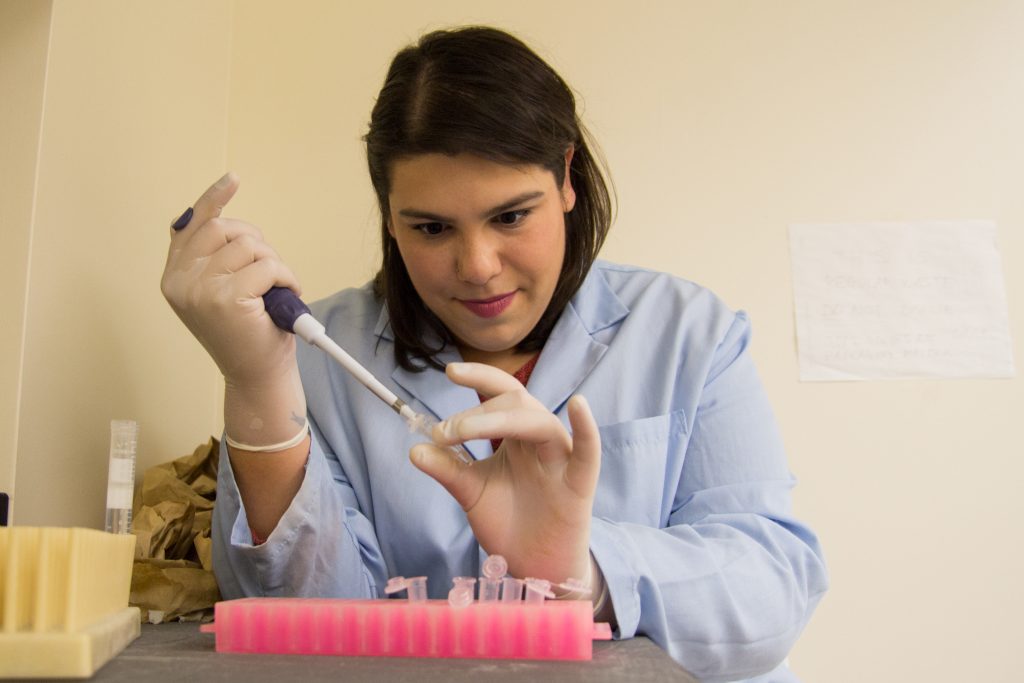
Once used to hold cigarettes and matches, a pair of silvered hooves from Seabiscuit are now being used at Binghamton University to research the genes of the champion racehorse.
Seabiscuit raced during the Great Depression and, after losing his first 17 races, was deemed too small to be successful within the horse-racing industry. After a change in ownership and trainer, the horse began to see success in the late 1930s, and according to Laura Hillenbrand’s 2001 book, “Seabiscuit: An American Legend,” he was an inspiration to the struggling people of America.
Steven Tammariello, director of the Institute for Equine Genomics and an associate professor of biology at BU, was contacted in 2017 by Jacqueline Cooper, president of the Seabiscuit Heritage Foundation, to do genetic testing on a fifth-generation descendant of Seabiscuit, Bronze Sea.
“We were trying to identify a suitable stallion choice for Bronze Sea,” Cooper said. “Dr. Tammariello and I were discussing Bronze Sea’s results and it was sort of a comment in passing. I said, ‘Well, it would be nice if we could figure out what genetic traits stem from Seabiscuit.’”
The difficulty was that tissue would be needed directly from Seabiscuit — a horse that died over 80 years ago and whose burial site is kept a secret by the family that owned the racehorse. Cooper reached out to Michael Howard, the great-grandson of Seabiscuit’s owner, who happened to know the whereabouts of the horse’s silvered hooves. The hooves of racehorses used to be commonly silvered to be used as ashtrays or to hold cigarettes, and covering the hooves with silver also preserves the bone.
Kate DeRosa, a fifth-year graduate student studying anthropology, was tasked with doing most of the research. DeRosa is trained in ancient DNA techniques, and any DNA collected after death is considered ancient, requiring a specific protocol for analysis.
“One of the concerns I had about working with Seabiscuit’s hooves was whether or not we would be able to extract DNA,” DeRosa wrote in an email. “Since we couldn’t actually see what was there, I had to carefully drill into the bottom of the hooves, making sure I did not damage the silver coating to find bone powder. Luckily, the coffin bone was intact and I was able to obtain several powder samples for extraction.”
The lab found that Seabiscuit’s genes expressed long-distance stamina, which gave him a clear advantage over his competition. But underlying those genes were additional ones often expressed in successful sprint horses.
This combination, according to Tammariello, is extremely rare and closely resembles the abilities of Justify, the 2018 winner of the Triple Crown, one of the most prestigious awards in the horse-racing industry.
“[Justify] was a pretty interesting one because he was able to sprint pretty well and maintain that sprint for [a] pretty long time,” Tammariello said. “Whereas, Seabiscuit mainly had these distance-running genes and underlying them were all sprinting genes. So he had speed and stamina as well, just going in the other direction.”
A problem in the horse-breeding industry, according to Cooper, is that many horses are used for the wrong type of race according to their genetic information. She said if a racehorse is not successful, it is often disregarded and left up to auction.
“I find genetic information invaluable, and if this technology would be accepted in the future by the horse-breeding community, then we could set [the horses] up for success,” Cooper said. “We would make better informed decisions and improve their lives.”
Seabiscuit’s genes are being researched further, but Tammariello said their lab is going to be looking away from the physical aspects of the horse.
“I’m more interested in his behavioral genetics, so genes like dopamine receptors and octopamine receptors, because we know those are linked to aggression and thrill-seeking and trainability,” Tammariello said. “It’ll be interesting to see if it was his mind that mostly carried him to his success, or was it only his physical attributes.”
Tammariello and DeRosa both said they expect to receive more results within the next few months.


